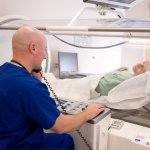Happy Thursday, mamas. Today we’re bringing you a Q&A about 3D breast mammography because many of us have either had one, will have one in the future or need to have one now.
After my routine mammogram earlier this year, something was found that required a closer look. I had two 3D mammograms as well as two ultrasounds, which thankfully showed that the abnormality was a harmless cyst. Going through that experience made me realize how important it is that women understand what 3D mammograms are and how they can help protect us by helping doctors make an accurate diagnosis.
 We asked Dr. Andrea Placzek and Dorothy Farmer, RT of Mercy’s mammography department to answer the following questions:
We asked Dr. Andrea Placzek and Dorothy Farmer, RT of Mercy’s mammography department to answer the following questions:
What is 3D mammography and how is it different from a regular mammogram?
A regular mammogram examines your breast from top to bottom and side to side. 3D does the same thing and also looks through the layers of your breast tissue to get a closer look, potentially finding smaller abnormalities.
There is really no difference to the patient with regard to compression or positioning.
Who is a good candidate for 3D mammography?
Anyone who would have a standard mammogram, usually beginning at age 40.
Can a patient request a 3D mammogram?
At most facilities they can. At Mercy, all patients are imaged using 3D technology.
Does insurance cover it?
Most insurances cover 3D mammograms, although you should check with your insurance provider.
What happens if the technician sees something on the 3D mammogram? What is the next step?
Technologists don’t read mammograms. They create quality images for the radiologist (a physician) to read. Diagnostic mammograms (performed if the patient has a problem with her breast) are read while the patient waits to see if additional imaging or ultrasound is needed that day. Results are received while at the appointment at Mercy.
Routine screening mammograms are not generally read the same day at Mercy but within the next day or so. If the radiologist sees something at the time of screening mammogram interpretation, the patient is notified to return for additional mammography images or an ultrasound, whatever is appropriate for the patient.
At Mercy, during the day of return and additional imaging, the patient is given results and explanation of the additional testing, which could include a biopsy if it’s required, referral to a surgeon, or short-term follow up.
What is the rate of “false positives” in 3D mammography?
3D reduces the rate of false positives by up to 40% per Hologic statistics.
While false positives sometimes result in a biopsy, at other times it’s only an additional mammogram image or ultrasound that is needed.
What do breast ultrasound technicians look for when diagnosing what may be breast cancer?
Ultrasound technologists are looking for size and shape, solid areas versus fluid-filled cysts.
How would a harmless cyst in the breast look different from a malignant mass?
Cysts are typically round or oval with smooth margins and are fluid-filled.
If a cancer diagnosis is made, what does the Breast Navigator do to help the patient through the next several steps of the treatment process?
The Breast Navigators at Mercy meet with patients all through the process of breast imaging, biopsy, diagnosis, education, treatment and survivorship. In many cases, patients have said the navigators become one of the family. They assist with biopsies, attend the first meeting with the surgeon to receive the news, and begin to formulate a plan. They are there to answer questions that arise, provide educational books and make appointments and contacts that are needed with oncologists, plastic surgeons and other referrals.
They see the patient post-surgery and keep in touch throughout the process to see that needs are met and things are going well. They are available to attend any appointment the patient needs them to attend, just as an extra set of ears and as a health advocate.
For more info about mammography, where to get one and when to get one, talk to your doctor or click here for mammogram information on the Mercy website.





